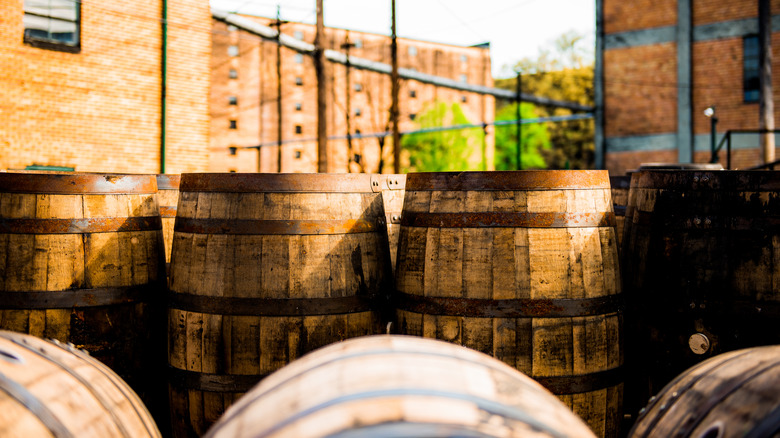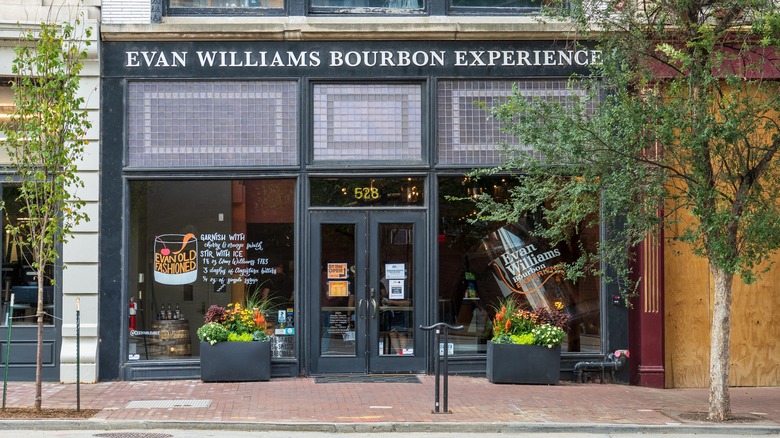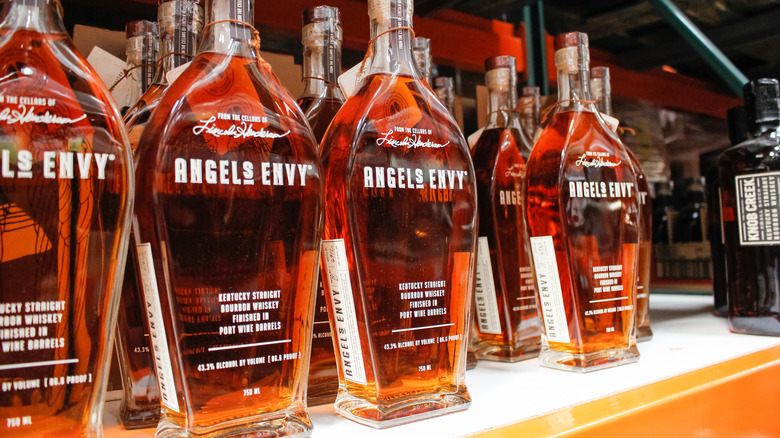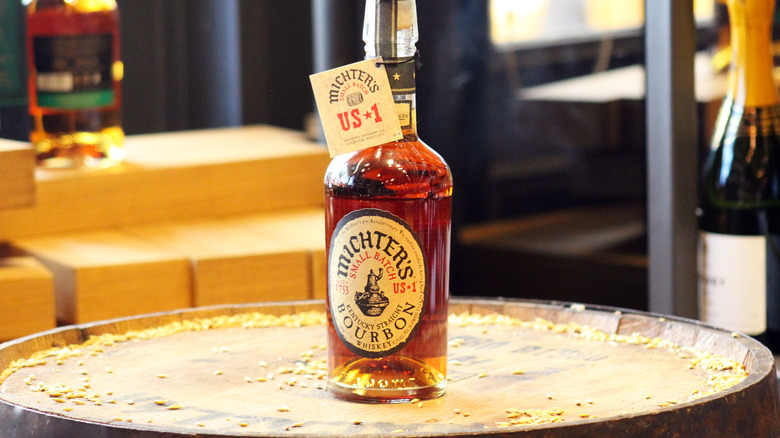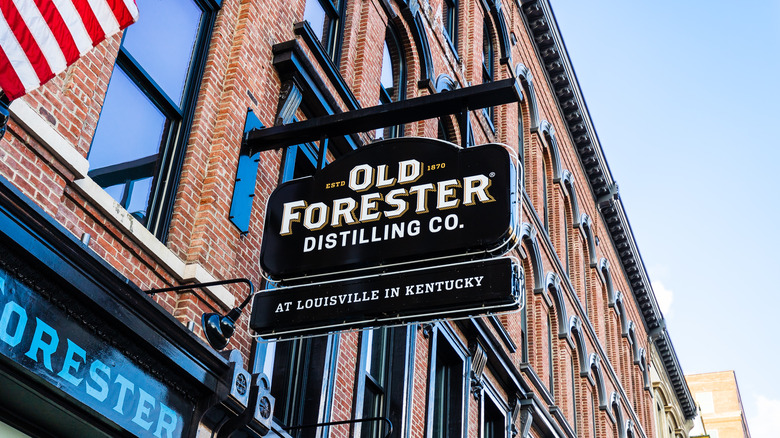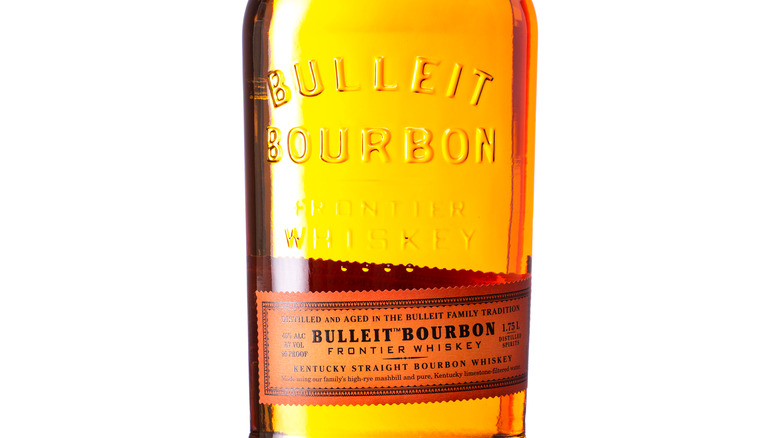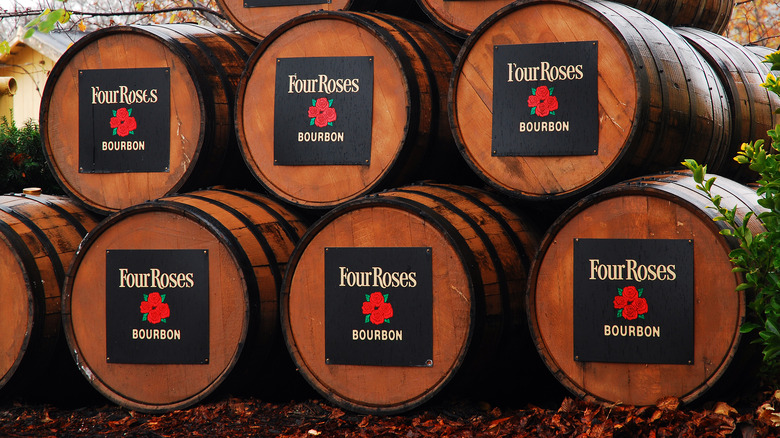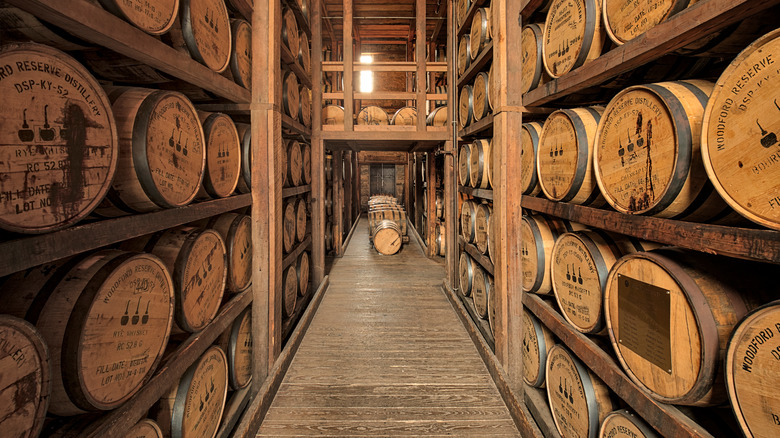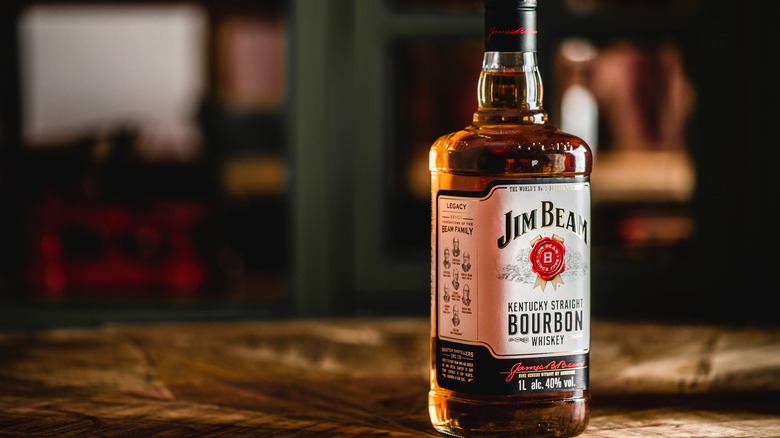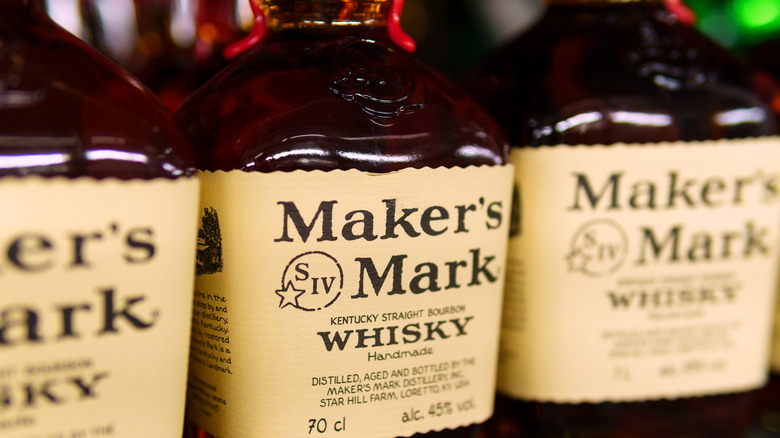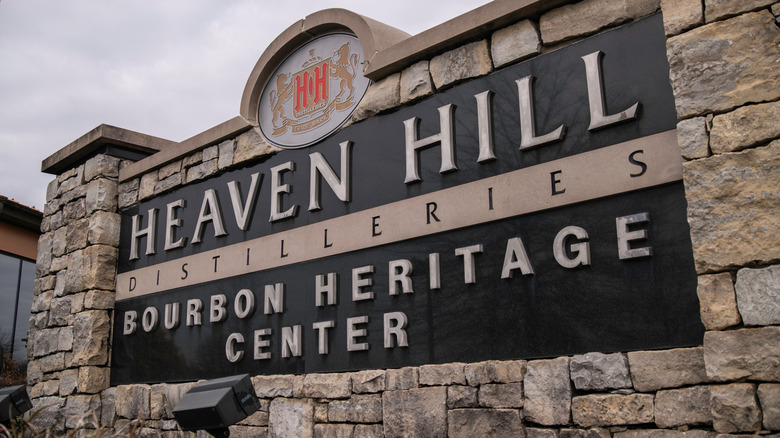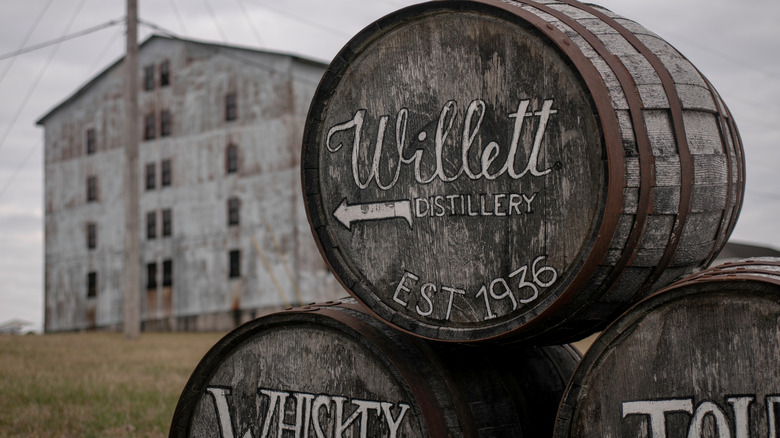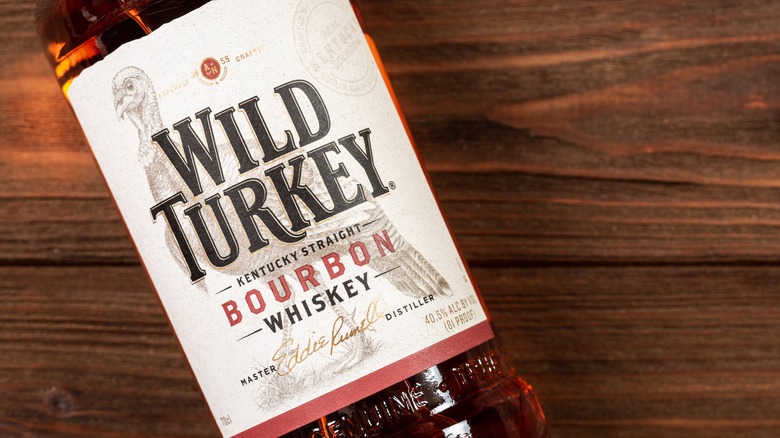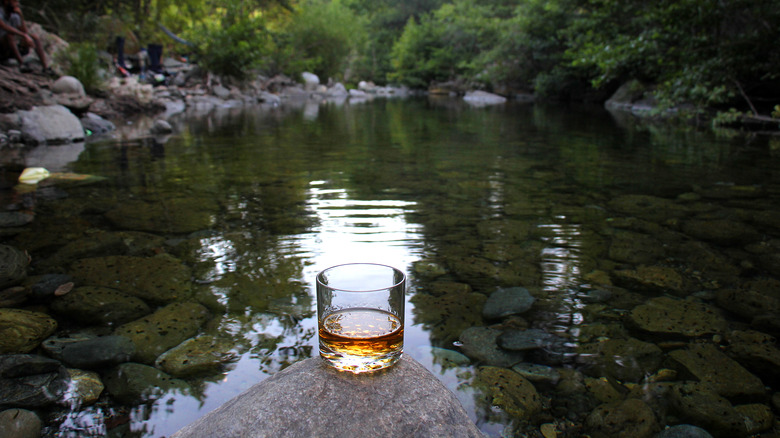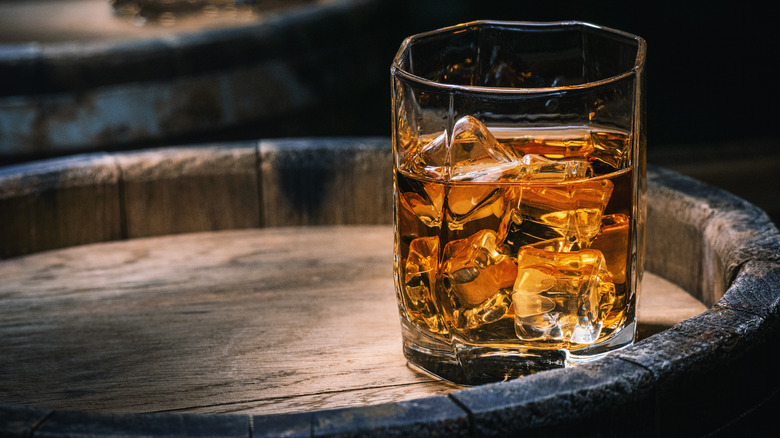14 Best Distilleries To Visit Along Kentucky's Bourbon Trail
There may not be another drink more mysterious than bourbon. It's known for caramel, vanilla, and oak notes, yet each bottle is unique, carrying different tastes, aromas, and surprising finishes. The amber-colored whiskey has been around since the 1700s when settlers in Kentucky (mainly Scottish, Irish, and German) realized they had the perfect soil for growing grains that would eventually be distilled as bourbon, according to History.com. Today, Kentucky still reigns as the number one producer of bourbon, claiming 95% of all bourbon distilleries.
It seems Kentucky was destined for the job. It isn't just the soil that makes the land perfect. Fred Minnick, author of "Whiskey Women" and "Bourbon Curious: A Simple Tasting Guide for the Savvy Drinker" tells History.com that the water plays a big factor because of how the natural limestone works to filter out minerals. That's right — even the water is perfect. All of that is to say if you love bourbon, Kentucky's Bourbon Trail is the place to be. With 37 distilleries, there is truly nowhere else on earth where you will find more bourbon within a 250-mile radius. Feel free to visit them all, but if you find it tough to choose, read on as we look at the best distilleries to visit along Kentucky's Bourbon Trail. Pack your bags and get started.
Evan Williams
According to Explore Kentucky History, Evan Williams is said to be the first commercial distillery in Kentucky. Evan Williams himself came to Louisville, Kentucky from Wales in 1780. You'll find a historical marker (#2445) in his honor in Louisville. Just three years later, after realizing he'd settled in a land where the soil and water were perfect for distilling bourbon, he opened a distillery.
The brand's website explains that its bourbon, named after Evan Williams himself, is aged even longer than required by law, creating a Kentucky Straight Bourbon with bold character. As the first distillery in Kentucky, placed along the banks of the Ohio River way back in 1783, Evan Williams is proud to still be delivering one of the smoothest bourbons for novices and connoisseurs alike to enjoy. Today, Evan Williams bourbon is distilled at Heaven Hill Distillery, and you can enjoy the Evan Williams experience in downtown Louisville where they offer tours, tastings, and a fun speakeasy area as well (via Bourbon Trail Tours).
Angel's Envy
If anything, you've got to visit Angel's Envy to hear the story of such a fantastic name. During the aging process of bourbon, some alcohol evaporates. It's said that the missing bourbon is the "angel's share," per Vine Pair, hence what's left is the angel's envy. You'll notice that Angel's Envy has a beautifully shaped bottle that is inspired by Angel's wings. Angel's Envy distillery is one of the youngest on the Kentucky Bourbon Trail, as it began in only 2011. Today, you'll find the distillery in downtown Louisville, as the first full-production distillery to open its doors in that city.
If you are looking for one of the smoothest bourbons in the world, you'll be in the right place at Angel's Envy. The distillery is known for bending rules in a good way, such as using second-barrel finishing techniques, which are usually only seen in the making of Scotch. Gentleman Ranter's explains that Angel's ages its bourbon in charred American oak barrels for up to six years and in the last few months it is moved to port wine casks, creating a drink that is ridiculously smooth and easy to sip.
Michter's
According to Michter's, George Washington bought bottles of their bourbon straight from the distillery back during the Revolutionary War to keep his men warm through the long winter at Valley Forge. If President Washington visited, you probably should as well. Michter's began its journey in Pennsylvania back in 1753. It was founded by a Swiss Mennonite farmer named John Shenk.
It wasn't until the 1990s that Michter's found its home in Kentucky, after a long history of dealing with issues such as prohibition, bankruptcy, and the near disappearance of the Michter name. This delightful and sometimes hard-to-find bourbon owes its rareness to barrels that are toasted before they are charred, which helps to expose deeper layers of the interior of the barrels, offering greater levels of flavor to the bourbon, per Cocktails and Bars. You can visit Michter's distillery along the Bourbon Trail in Louisville, right across from the Louisville Slugger Museum.
Old Forester
In case you haven't noticed, most bourbon is steeped in history and heritage, and that's one of the reasons bourbon drinkers love it. Old Forester doesn't disappoint in this area. The founder, George Garvin Brown of Munfordville, Kentucky, created the first bottle of Forester in 1870, according to the brand's website. After purchasing the Mattingly Distillery, George created the first double-barreled bourbon, called "Very Old Fine Whisky," in 1910. A fire shut down production, so the whisky was all dumped, and although it was ready to bottle, he decided to put it all into second barrels. The stories just get better. In the 1940s, during World War II, the Old Forester distillery converted the entire production line so they could produce industrial-grade alcohol. This was done to help out the troops and the entire war effort. You just have to love bourbon stories.
A fun tidbit about Old Forester is that it is the only bourbon that has remained in the same company before, during, and after prohibition. Tour Old Forester and hear all the great stories about George Garvin Brown on Whiskey Row in Louisville, Kentucky.
Bulleit
Everything you need to know about Bulleit bourbon is summed up by the distillers on its website, which reads "Our aging philosophy is simple: We wait until our bourbon is ready." Simple, yet essential words that describe a bourbon known for its extra spice and smoothness. Bulleit's claim to fame is their higher use of rye in the mash.
As with many bourbons, the story starts out a bit sad but has a happy ending. The Rum Howler Blog writes that Augustus Bulleit, the creator of Bulleit bourbon back in 1830, disappeared while transporting the bourbon across the country, and Bulleit bourbon disappeared as well for over 100 years. Thankfully, generations later, Thomas E. Bulleit, Jr. said enough is enough and brought Bulleit bourbon back to life. According to Bourbonr, it's not a whiskey that is difficult to run across. You'll see it in most bars and liquor stores; however, as a common shelf bourbon, it gives novices and connoisseurs a unique taste, unlike some of the others on the shelf. Check out Bulleit bourbon at the Bulleit Distilling Co. in Shelbyville, Kentucky.
Four Roses
Ready for a little romance? Four Roses has you covered. It starts with a tempting beauty and ends with a "yes" to a proposal. According to Four Roses Bourbon, Paul Jones, Jr. fell in love with a Southern belle and had to have her. In the most romantic gesture ever, he wrote a letter to her, asking for her hand in marriage. To top his amorous proposal, she replied by writing that she would wear a rose corsage to the grand ball they would both be attending if her answer were "yes." And, you guessed it — she wore four roses. Jones was certainly relieved to not be humiliated with a "no" and we are all relieved he continued to make fine bourbon, aptly naming it Four Roses.
Four Roses is known for the fact that it has 10 different bourbon recipes, and each has its own notes. This is done by creating different yeast strains and separate mash bills. The distillery is as gorgeous as the romantic rose label and can be toured along the Kentucky Bourbon trail in Lawrenceburg, Kentucky.
Woodford Reserve
If you drink bourbon, you've heard of Woodford Reserve. It's one of the most popular bourbons out there. And although the price point is a decent one at around $50 a bottle, Woodford Reserve is considered a premium bourbon.
According to The Spirits Educator, the story of Woodford Reserve begins in the cute little Kentucky town of Versailles. There, a man named Elijah Pepper began to distill corn into whiskey in 1797. His son would then take over in 1835 and hire a Scottish scientist to help with the distilling process. That scientist, Dr. James C. Crow, is credited with inventing the sour mash that is still used in bourbon fermenting today. After a few more changes in hand, the distillery would eventually end up with Brown-Forman in 1994 and the bourbon was named Woodford after the county in which it resides.
The distillery, which is along the Kentucky Bourbon Trail, is considered one of the most beautiful ones to see. Woodford Reserve's website explains that they offer several different tour options and you should aim to book them a few months in advance because they sell out.
Jim Beam
The history of Jim Beam began with the American dream and some corn. The Boehm family hailed from Germany and arrived in America in 1740 when the country was still 13 colonies. Fast forward 48 years and the family not only moved to Kentucky to take advantage of government incentives that were offered for farming corn, but they also Americanized their name as many immigrants did back then, to Beam (via JimBeam.com).
Whiskey, namely rye whiskey, was already popular by then, but Jacob Beam made the decision to start using up excess corn and turned it into a mash for distilling. Their bourbon whiskey was born and folks all over loved Jim Beam. He sold his first barrel in 1795, and the story continues today. By the way, Kentucky already had 2,000 distilleries by the early 1800s, so selling a barrel of a new one you've made was no easy task.
Bourbon law says you must age the whiskey at least two years for it to be considered bourbon. However, Jim Beam is known for its four-year aging process to bring bourbon fans a satisfyingly smooth spirit. Seeing the Jim Beam distillery is seeing a business that began two centuries ago. You'll find them in Clermont, Kentucky where they offer tours and Kentucky hospitality.
Maker's Mark
Maker's Mark begins with Bill Samuels, Sr., who is quoted as saying he wanted a bourbon "that won't blow my ears off," per the brand's website. And that's what happened, but let's back it up a little first. Bill's family already had a bourbon recipe that was 170 years old. He decided to experiment with it, determined to create a bourbon that wouldn't blow his ears off and he, well ... set the drapes on fire, along with the ancient family recipe, while doing so. Thankfully, Bill had spunk and he continued on. He wisely used bread making to experiment with grains and soon he'd find the secret that would make Maker's Mark stand out amongst the bourbon crowd — red winter wheat instead of rye. Brilliant.
It's the red winter wheat that gives Maker's its sweet notes, making it an excellent bourbon in cocktails like the Old Fashioned, and also perfect for sipping neat so you can enjoy Maker's Mark's delicately sweet notes.
We can't end without discussing the dripping red wax that seals the bottle. It's purely decorative and was designed by one of the first women in the bourbon industry, Margie Samuels, whose name resides in the Kentucky Bourbon Hall of Fame. The red wax makes Maker's Mark stand out on the shelves and consumers can't help but be curious. Visit Maker's Mark in Loretto, Kentucky along the Bourbon Trail.
Heaven Hill
Prohibition ended and the Shapira family got busy making bourbon. Heaven Hill Brands writes that the family was taking quite a risk. The Great Depression was at its peak, the family had no whiskey at the time, and no brand of their own. Today, something people often don't realize about Heaven Hill is that it's the largest, independent, family-owned distillery in the world today, making 19 different bourbons and whiskeys, including Evan Williams and Elijah Craig. The distillery makes a whopping 1,300 barrels a day. Hard work and a dream pay off.
Heaven Hill Distillery explains that the business began in Bardstown, Kentucky by a gentleman named William Heavenhill. The name was misspelled one time as "Heaven Hill" while filling out official paperwork as the business was being formed. It would have cost $10 to fix it, so the separated words of the name remained.
One of the Shapira brothers, Max, was once quoted as saying, "When you're in the business of making products that you can't sell for four years or longer, it takes patience and perseverance" (via Heaven Hill Distillery). It certainly does. Eventually, the Jim Beam family entered the picture and helped make Heaven Hill the world-renowned distillery it is today. You can visit this amazing place in downtown Louisville, Kentucky.
Willet
Willet Distillery is one of the last truly family-owned distilleries in Kentucky. They are very proud of it and believe so highly in their family-owned business that they regularly turn down investors. At one point, the distillery closed because of the financial pressures that came in the 1980s when clear spirits, such as vodka, were king. Fast forward to 1984, when the Kulsveen couple purchased the property from the Willets and brought the Willet Distillery back to life. From there, Willet would become seriously premium. It's one of the most expensive bourbons in the world, with some bottles selling for $4,000.
Willet is known for its willingness to share things, such as its mash bill, with the public. Most distilleries keep those numbers a secret. Because of the past history of Willet, especially having to close the doors at one time, Drew Kulsveen was quoted in Whisky Magazine as saying that customer tastes dictate their business. If people have a change of taste, we have to protect ourselves." That's why they are now seeking the distilling of other spirits as well. Visit the Willet Distillery, rich in history, in Bardstown, Kentucky.
Wild Turkey
It took three different stories to merge and bring us the beloved American bourbon called Wild Turkey, according to The Whiskey Jug. It includes the Ripy family who began a distillery called Old Moore in 1850. Then the story continues with a change in name to Austin Nichols, since the Ripys merged with that distillery, and finally, in 1940 we see the first bottle that's named Wild Turkey, which Austin Nichols came up with while hunting turkeys. By the way, in 2016, Matthew McConaughey became the creative director for the distillery.
Wild Turkey prides itself in using only non-GMO corn in their mash bill (which is kept quite secretive). Bourbon Obsessed points out that Wild Turkey is a classic bourbon, delivering those bourbon notes you'd expect while also hitting your nose and palate with a surprising spiciness.
The distillery is located in Lawrenceburg, Kentucky, and offers plenty of tours for Kentucky Bourbon Trail visitors. Wild Turkey writes that its new visitors' site is something to see, and it has even received several awards.
Green River
Along the bourbon trail, you'll find craft distilleries, which are smaller distilleries that are motivated by innovation and creativity, obeying the laws of bourbon production, of course, but also looking for new ways to make it even better. When it comes to innovation today, Green River Distillery is at the forefront.
Green River believes in doing things correctly because bourbon is bourbon. Master distiller at Green River Distillery, Jacob Call explains that making good bourbon doesn't require a magic bullet. There are certain processes that have to be followed and the right ingredients have to be used. On the other hand, the distillery also believes in shaking up the bourbon world by trying new things, such as aging bourbon in unique barrels. Green River is currently experimenting with wine and rum barrels.
If that isn't enticing enough, all of Green River Distillery's corn is locally sourced, often within just a few miles of the distillery. On top of that, they give 1% of their sales to environmental causes. It's not just a distillery in Kentucky. It's a part of Kentucky and cares about the environment. Visit this innovative craft distillery along the Kentucky Bourbon Trail in Owensboro, Kentucky.
Castle and Key
The distillery, Old Taylor, which once housed the infamous bourbon Colonel G.H. Taylor, was left abandoned until Castle and Key purchased the property and restored it into something beautiful, according to Sipping History. It was Will Arvin, in 2012, who visited the grounds of the old distillery and found roofs caving in, weeds growing wild, and, all in all, a historical place that was falling apart. He fell in love and the site for Castle and Key was born. Castle and Key is another new craft distillery, but the building and grounds that house it are full of rich history. Thanks to the restoration, tours are now happening again, and visitors hear not only the new Castle and Key story but the stories of Old Taylor as well.
Castle and Key writes that quality is of the utmost importance to the distillery. After all, it's practically on hallowed ground. The distillery make this promise clear by encouraging customers to let them know how they feel about the bourbon and their experiences. Although this craft distillery is along the bourbon trail, Castle and Key offers more than bourbon. It also distills gin, vodka, and rye whiskey. There's something for everyone. Visit Castle and Key in Frankfort, Kentucky.
